Lacewings
Lacewings are insects in the order Neuroptera. They have slender elongate bodies, long thread-like antennae and prominent eyes. Their common name is derived from the many prominent veins on their two transparent pairs of wings, giving them a lacelike appearance. In some species the wings are patterned with dark markings.
Lacewings vary in colour and size. Most have bodies that are pale green, black or brownish and are 5-25mm long. Species in the genra Coniopteryx and Conwentzia species are much smaller and their wings are covered with a white waxy powder, secreted on the abdomen and spread using the rearmost legs. This gives them a similar appearance to sap-sucking insects known as whiteflies.
The larvae of lacewings have elongate bodies that taper towards the rear end, and their legs are splayed out to the side. The larvae have a pair of large curved jaws that are used to seize their prey and suck out the contents.
Species in Britain and Ireland
There are more than 40 species of green, brown and other lacewings in Britain and Ireland. Some are associated with particular habitats, such as coniferous trees but others are widespread in their occurrence. Jennifer Owen recorded no less than 23 species in her Sheffield garden, from four families, mostly from Malaise trap samples. The commonest were the brown lacewing Wesmaelius subnebulosus asssociated with birch Betula spp. and the green lacewing Chrysoperla carnea.
Biology
The adult insects are mainly active at night and may be attracted to bright lights. They feed on pollen and honeydew, which is the sugary excrement produced by aphids and some other sap-sucking insects. Some species will also feed as adults on aphids and other small insects.
Most lacewing larvae are voracious predators of aphids, adelgids and other small invertebrates. Some green lacewing larvae have bristly hairs on their upper surface in which the remains of past meals and other debris become lodged. This presumably helps the larvae hide from birds and other predators. Sisyra species have larvae that are aquatic and they feed on freshwater sponges.
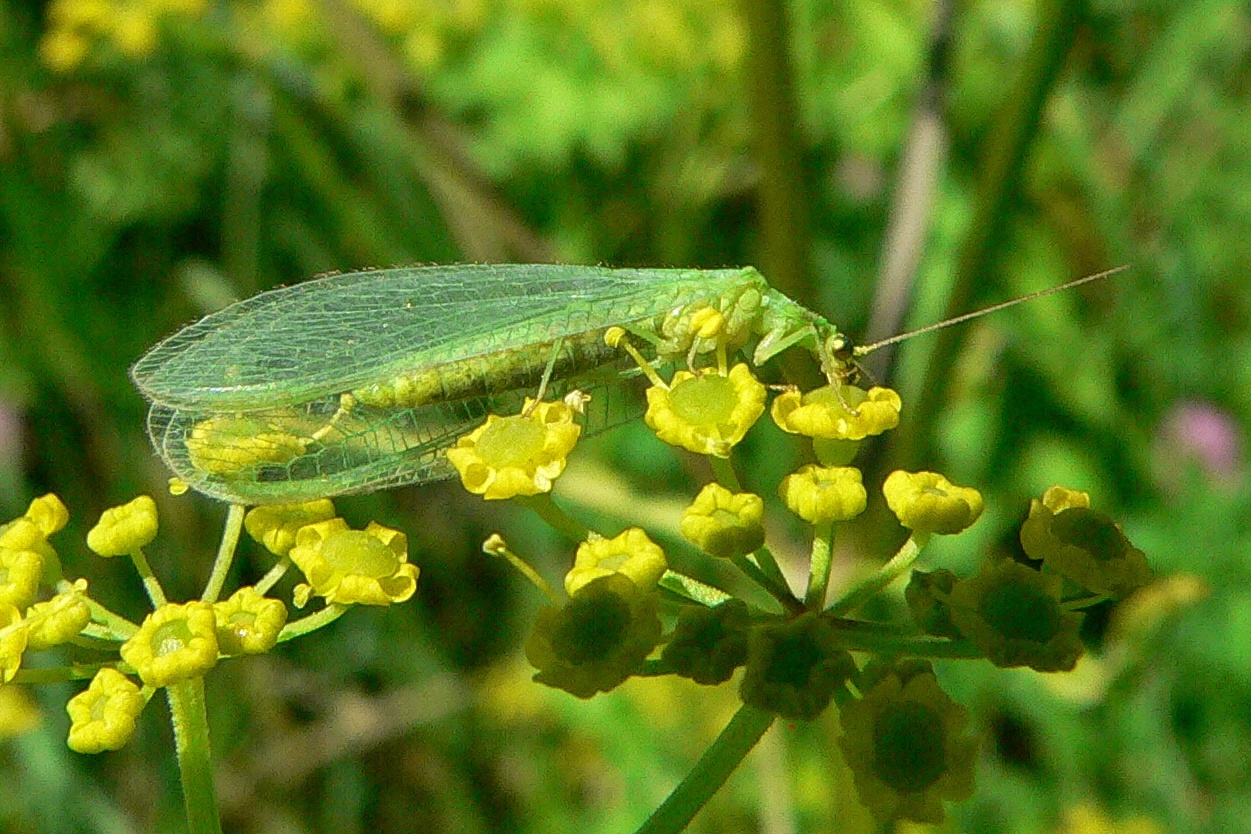
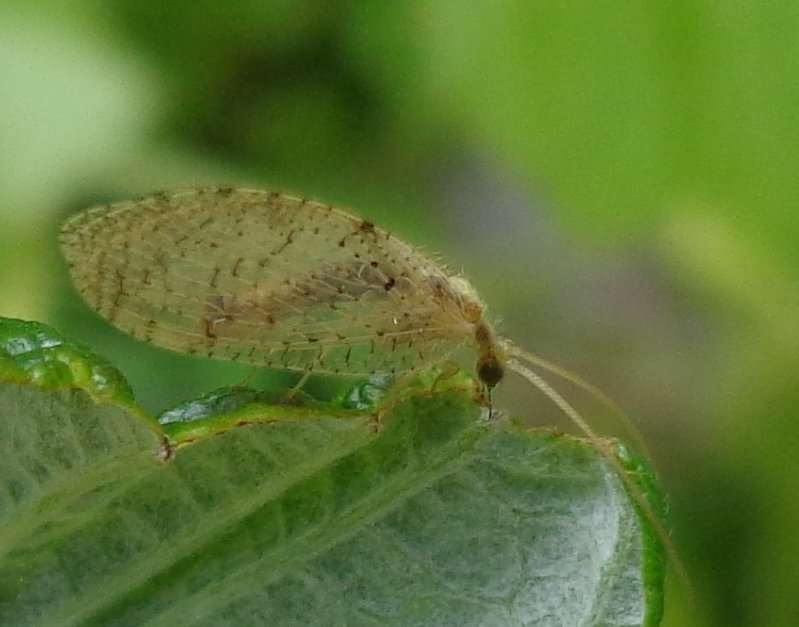
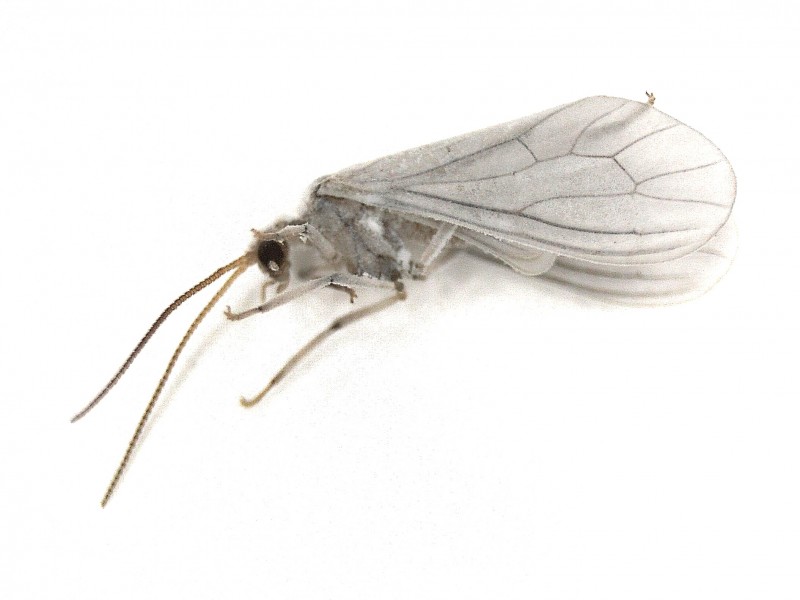
Above Left: Brown lacewing Wesmaelius subnebulosus Right: Green lacewing Chrysoperla carnea
Below Left: Brown lacewing Herobius humulinus Right: Waxy lacewing Conwentzia psociformis
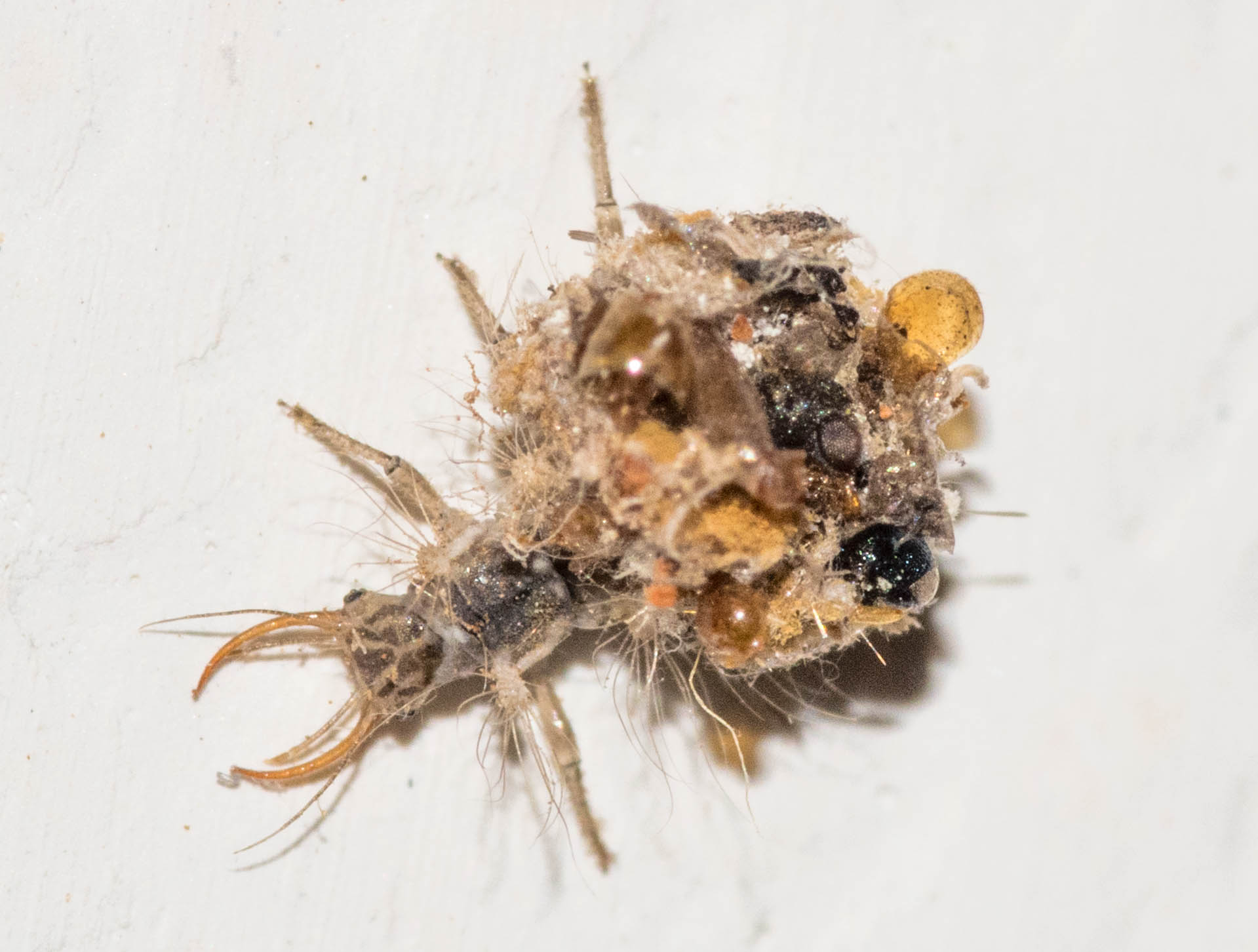
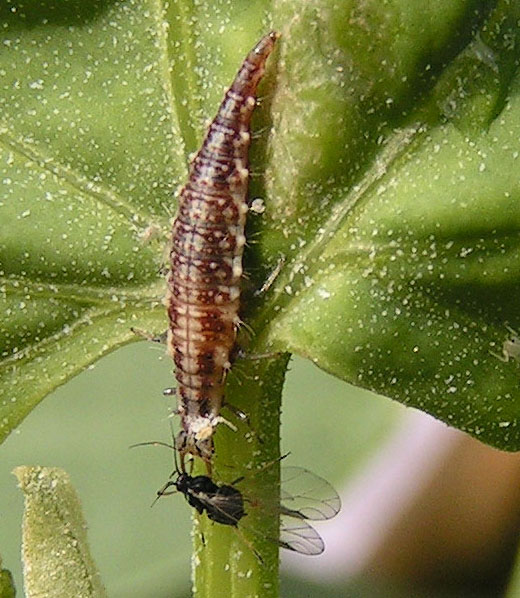
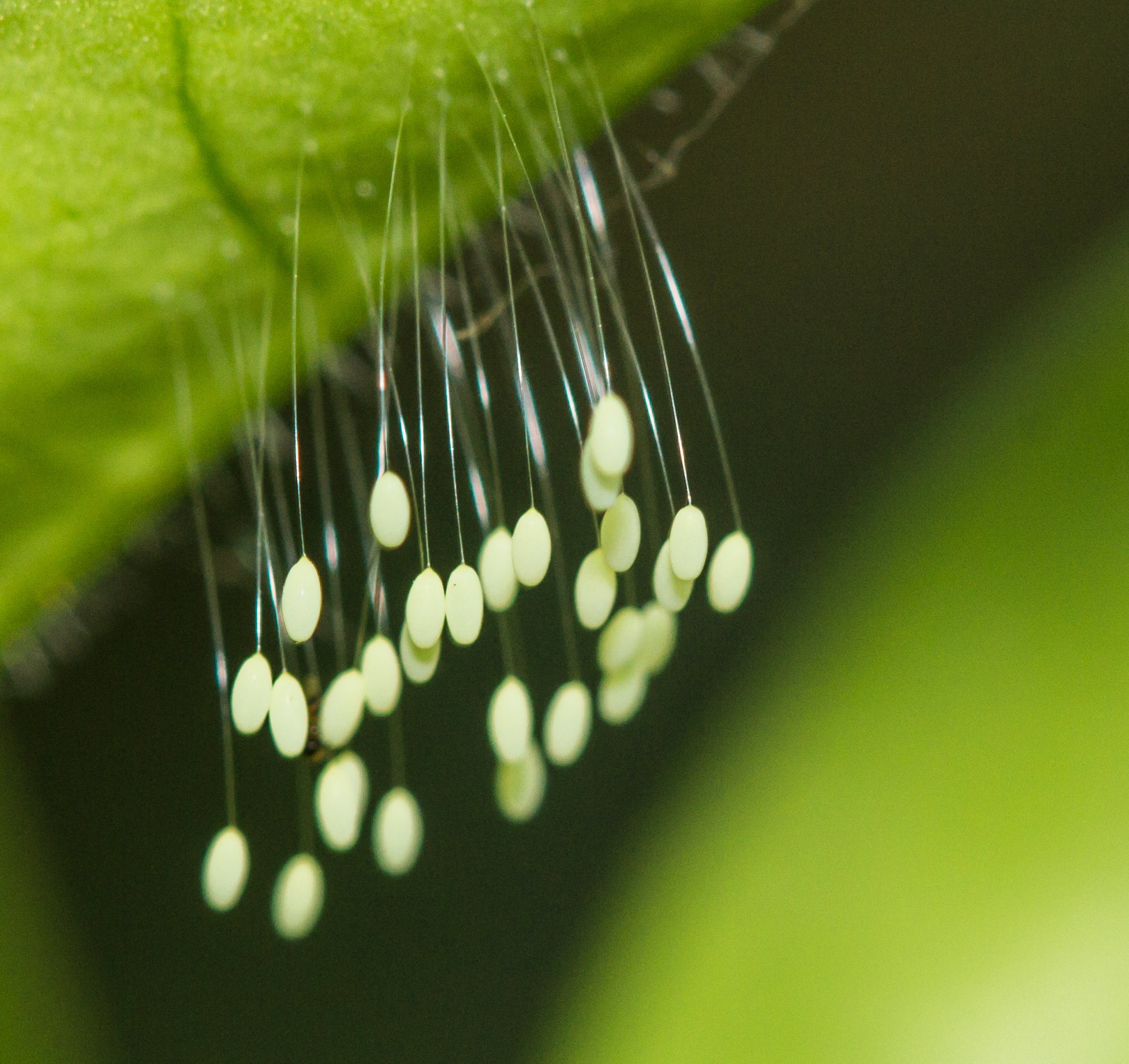
Green lacewing Chrysoperla carnea larva eating a small fly Right: Lacewing larva camouflaged with debris
Life cycle
Lacewings are holometabolous insects with complete metamorphosis. Green lacewings produce a quick-drying sticky fluid when they lay an egg. The egg is lifted up before it is released, resulting in it being attached to the leaf surface by a stalk 3-4mm long. Some species deposit eggs singly but some lay them in small clusters. Brown lacewings place their eggs in bark crevices. The larval stages feed on aphids and other small insects. When fully fed, they spin silk cocoons and pupate. Most species overwinter as pupae but the common green lacewing, Chrysoperla carnea, overwinters in sheltered places as an adult insect. They are sometimes found in houses and garden sheds. In autumn the overwintering adults change colour from green to straw yellow.
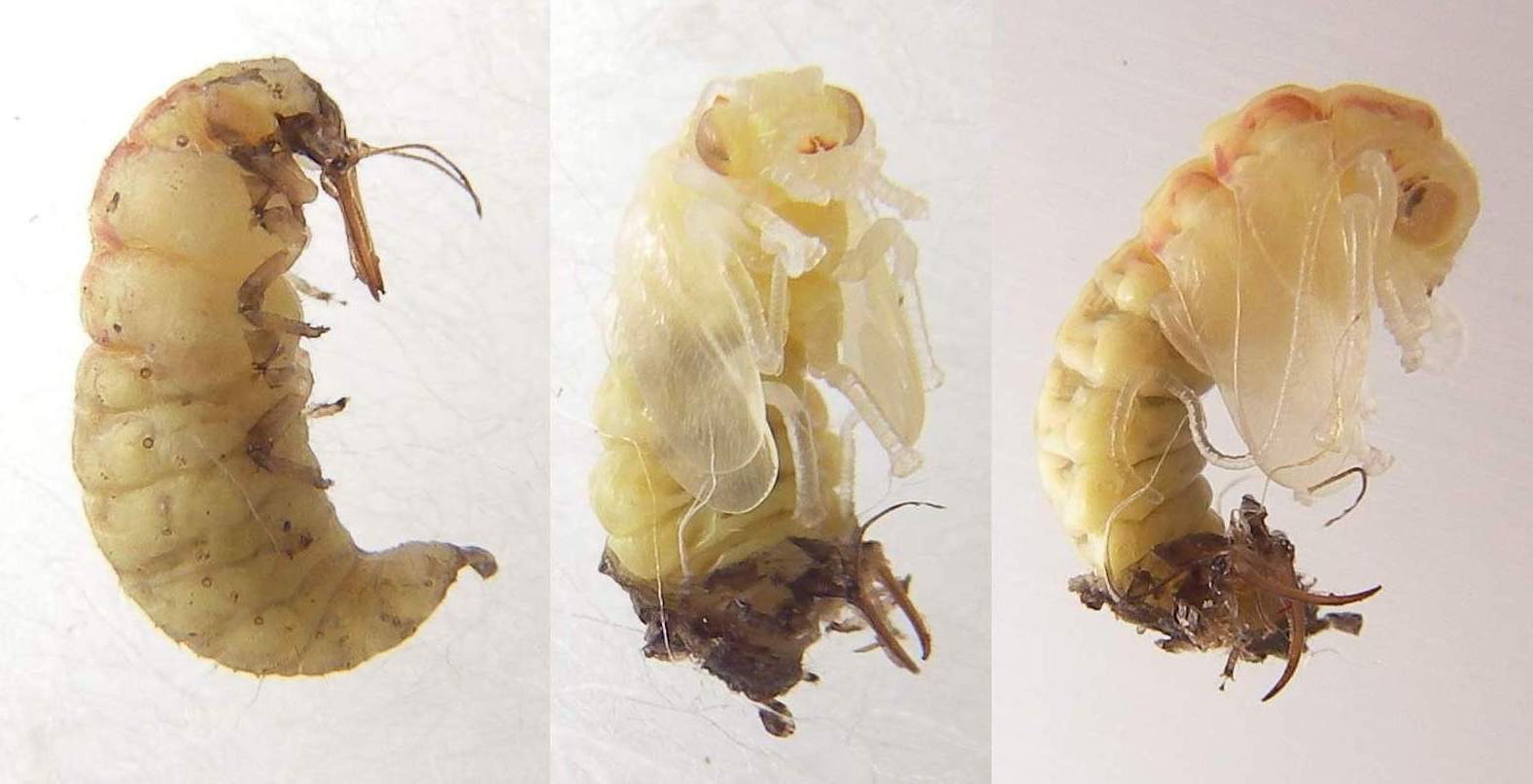
Left: Lacewing egg cluster Right: Green lacewing last instar changing to a pupa
Role of lacewings in gardens
Lacewings and particularly their larvae are useful predators in gardens, as the preferred prey of many common garden species is aphids. A green lacewing, Chrysoperla carnea, can be purchased as a biological control for aphids in greenhouses or on garden plants.
Other sources of information
Website
Website of the Lacewing and allies recording scheme
Book
Plant, C. W. A key to the adults of British lacewings and allies. A Field Studies Council AIDGAP key, Preston Montford, Shrewsbury
Page text drafted by Andrew Halstead, reviewed by Andrew Salisbury, compiled by Steve Head
Above Left: Brown lacewing Wesmaelius subnebulosus Right: Green lacewing Chrysoperla carnea
Below Left: Brown lacewing Herobius humulinus Right: Waxy lacewing Conwentzia psociformis

Lacewings
Lacewings are insects in the order Neuroptera. They have slender elongate bodies, long thread-like antennae and prominent eyes. Their common name is derived from the many prominent veins on their two transparent pairs of wings, giving them a lacelike appearance. In some species the wings are patterned with dark markings.
Lacewings vary in colour and size. Most have bodies that are pale green, black or brownish and are 5-25mm long. Species in the genra Coniopteryx and Conwentzia species are much smaller and their wings are covered with a white waxy powder, secreted on the abdomen and spread using the rearmost legs. This gives them a similar appearance to sap-sucking insects known as whiteflies.
The larvae of lacewings have elongate bodies that taper towards the rear end, and their legs are splayed out to the side. The larvae have a pair of large curved jaws that are used to seize their prey and suck out the contents.
Species in Britain and Ireland
There are more than 40 species of green, brown and other lacewings in Britain and Ireland. Some are associated with particular habitats, such as coniferous trees but others are widespread in their occurrence. Jennifer Owen recorded no less than 23 species in her Sheffield garden, from four families, mostly from Malaise trap samples. The commonest were the brown lacewing Wesmaelius subnebulosus asssociated with birch Betula spp. and the green lacewing Chrysoperla carnea.


Biology
The adult insects are mainly active at night and may be attracted to bright lights. They feed on pollen and honeydew, which is the sugary excrement produced by aphids and some other sap-sucking insects. Some species will also feed as adults on aphids and other small insects.
Most lacewing larvae are voracious predators of aphids, adelgids and other small invertebrates. Some green lacewing larvae have bristly hairs on their upper surface in which the remains of past meals and other debris become lodged. This presumably helps the larvae hide from birds and other predators. Sisyra species have larvae that are aquatic and they feed on freshwater sponges.


Green lacewing Chrysoperla carnea larva eating a small fly Right: Lacewing larva camouflaged with debris
Life cycle
Lacewings are holometabolous insects with complete metamorphosis. Green lacewings produce a quick-drying sticky fluid when they lay an egg. The egg is lifted up before it is released, resulting in it being attached to the leaf surface by a stalk 3-4mm long. Some species deposit eggs singly but some lay them in small clusters. Brown lacewings place their eggs in bark crevices. The larval stages feed on aphids and other small insects. When fully fed, they spin silk cocoons and pupate. Most species overwinter as pupae but the common green lacewing, Chrysoperla carnea, overwinters in sheltered places as an adult insect. They are sometimes found in houses and garden sheds. In autumn the overwintering adults change colour from green to straw yellow.


Left: Lacewing egg cluster Right: Green lacewing last instar changing to a pupa
Role of lacewings in gardens
Lacewings and particularly their larvae are useful predators in gardens, as the preferred prey of many common garden species is aphids. A green lacewing, Chrysoperla carnea, can be purchased as a biological control for aphids in greenhouses or on garden plants.
Other sources of information
Website
Website of the Lacewing and allies recording scheme
Book
Plant, C. W. A key to the adults of British lacewings and allies. A Field Studies Council AIDGAP key, Preston Montford, Shrewsbury
Page text drafted by Andrew Halstead, reviewed by Andrew Salisbury, compiled by Steve Head
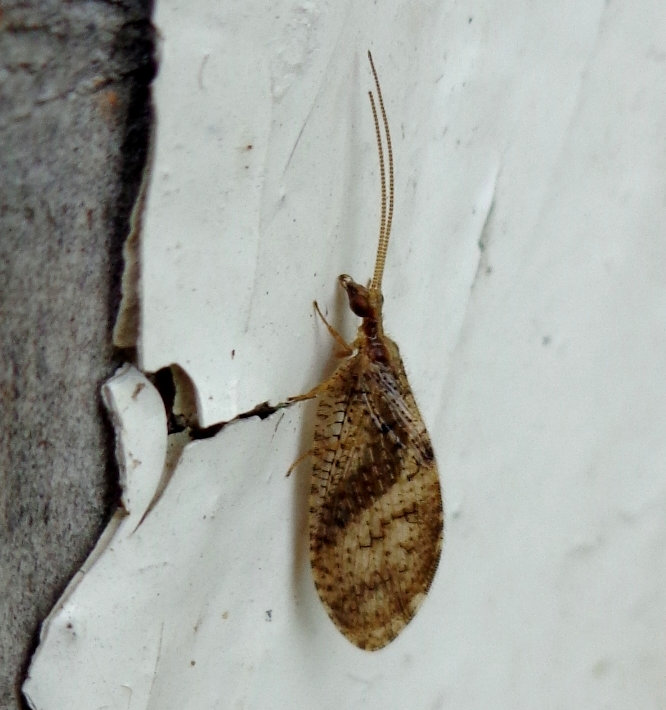

- Home
- Garden Wildlife
- Insects
- Lacewings












